BROWN BOOBY BIRD
 The Brown Booby (Sula leucogaster) is a captivating seabird that graces the coastal landscapes of Cayman Brac. With its distinct appearance and remarkable behaviors, it is a remarkable addition to the island’s biodiversity. Nesting predominantly on the rugged coastal cliffs of the Bluff, the Brown Booby has found a niche in this unique habitat. Its plumage, characterized by brown or grayish-brown tones, contrasts beautifully with its white underparts, while its pale blue bill adds a touch of vibrancy. This seabird’s lifestyle is equally intriguing, as it is a skilled diver and fisher. The Brown Booby takes to the air with elegance and precision, plunging into the crystal-clear waters in search of its marine prey. Its mastery of aerial acrobatics and aquatic hunting makes it a true marvel of Cayman Brac’s coastal ecosystem.
The Brown Booby (Sula leucogaster) is a captivating seabird that graces the coastal landscapes of Cayman Brac. With its distinct appearance and remarkable behaviors, it is a remarkable addition to the island’s biodiversity. Nesting predominantly on the rugged coastal cliffs of the Bluff, the Brown Booby has found a niche in this unique habitat. Its plumage, characterized by brown or grayish-brown tones, contrasts beautifully with its white underparts, while its pale blue bill adds a touch of vibrancy. This seabird’s lifestyle is equally intriguing, as it is a skilled diver and fisher. The Brown Booby takes to the air with elegance and precision, plunging into the crystal-clear waters in search of its marine prey. Its mastery of aerial acrobatics and aquatic hunting makes it a true marvel of Cayman Brac’s coastal ecosystem.
MAGNIFICENT FRIGATEBIRD

The magnificent frigatebird (Fregata magnificens) is a seabird of the frigatebird family Fregatidae. With a length of 89–114 centimetres (35–45 in) and wingspan of 2.17–2.44 m (7.1–8.0 ft) it is the largest species of frigatebird. It occurs over tropical and subtropical waters off America, between northern Mexico, Ecuador on the Pacific coast and between Florida and southern Brazil along the Atlantic coast and in the Caribbean . There are also populations on the Galápagos Islands in the Pacific and the Cape Verde islands in the Atlantic.
The magnificent frigatebird is a large, lightly built seabird with brownish-black plumage, long narrow wings and a deeply forked tail. The male has a striking red gular sac which it inflates to attract a mate. The female is slightly larger than the male and has a white breast and belly. Frigatebirds feed on fish taken in flight from the ocean’s surface (often flying fish), and sometimes indulge in kleptoparasitism, harassing other birds to force them to regurgitate their food.
GREEN HERON
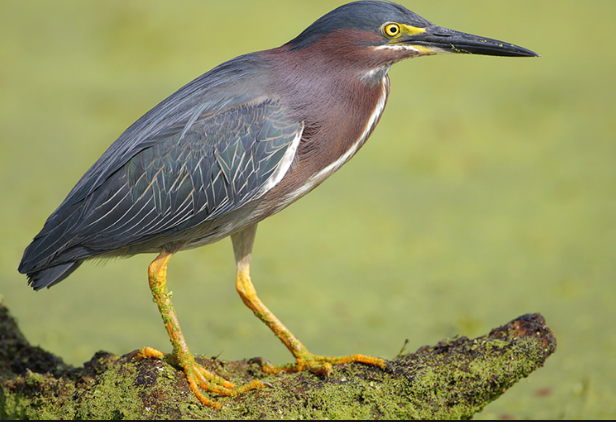
The green heron is a small heron of North and Central America. Butorides is from Middle English butor “bittern” and Ancient Greek -oides, “resembling”, and virescens is Latin for “greenish.
Green-backed heron” is a collective term for certain herons. Small and compact among herons, these birds often feature green plumage – rare among the Ardeidae –, in particular on the back, wings and scapulars.
They were formerly believed to make up a single species Butorides striatus, but are now treated as three largely allopatric species:
- Striated heron, Butorides striata – Widespread throughout the Old World tropics and in South America (Note that the grammatical gender of the specific name has been corrected from striatus)
- Lava heron, Butorides sundevalli – Endemic to the Galápagos Islands off Ecuador
- Green heron, Butorides virescens – Widespread from temperate North America south to Panama
These herons are tool-using animals. They are regularly seen picking up objects to use as a fishing lure, attracting prey fish.
The green heron (Butorides virescens) is a small heron of North and Central America. Butorides is from Middle English butor “bittern” and Ancient Greek -oides, “resembling”, and virescens is Latin for “greenish.
It was long considered conspecific with its sister species the striated heron (Butorides striata), and together they were called “green-backed heron”. Birds of the nominate subspecies (no matter which taxonomic arrangement is preferred) are extremely rare vagrants to western Europe; individuals from the Pacific coast of North America may similarly stray as far as Hawaii.
GREAT EGRET
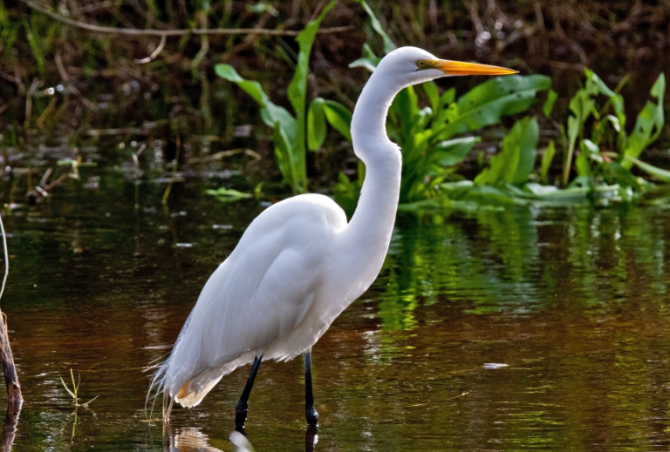
The great egret (Ardea alba), also known as the common egret, large egret or (in the Old World) great white heron, is a large, widely distributed egret, with four subspecies found in Asia, Africa, the Americas, and southern Europe. Distributed across most of the tropical and warmer temperate regions of the world. It builds tree nests in colonies close to water.
This long-legged, S-necked white bird is found throughout the Americas and around much of the world. It is typically the largest white egret occurring anywhere in its range (only the white-colored form of the great blue heron is larger).
Great egrets are found near water, salt or fresh, and feed in wetlands, streams, ponds, tidal flats, and other areas. They snare prey by walking slowly or standing still for long periods, waiting for an animal to come within range of their long necks and blade-like bills. The deathblow is delivered with a quick thrust of the sharp bill, and the prey is swallowed whole. Fish are a dietary staple, but great egrets use similar techniques to eat amphibians, reptiles, mice, and other small animals.
These birds nest in trees, near water and gather in groups called colonies, which may include other heron or egret species. They are monogamous, and both parents incubate their three to four eggs. Young egrets are aggressive towards one another in the nest, and stronger siblings often kill their weaker kin so that not all survive to fledge in two to three weeks.
The great egret is the symbol of the National Audubon Society and represents a conservation success story. The snowy white bird’s beautiful plumage made it far too popular in 19th-century North America. Great egrets were decimated by plume hunters who supplied purveyors of the latest ladies’ fashions. Their populations plunged by some 95 percent. Today the outlook is much brighter. The birds have enjoyed legal protection over the last century, and their numbers have increased substantially.
BANANA QUIT

The banana quit is a species of passerine bird of uncertain relation. It is tentatively placed in the tanager family, but classified as incertae sedis by other authorities such as the American Ornithologists’ Union.
The bananaquit (Coereba flaveola) is a species of passerine bird of uncertain relation. It is tentatively placed in the tanager family, but classified as incertae sedis by other authorities such as the American Ornithologists’ Union. Its classification is debated, and it is often placed in its own family: Coerebidae. It has recently been suggested the bananaquit should be split into three species, but this has yet to receive widespread recognition. This small, active nectarivore is found in warmer parts of the Americas, and is generally common.
Fond of nectar, this little bird often creeps about in flowering trees, probing the blossoms. It is widespread in the American tropics and especially numerous in the West Indies, including the Bahamas. Strays from the Bahamas have turned up a number of times in southern Florida, mainly in winter.
The Bananaquit inhabits a variety of habitats from scrubland to tropical lowland forest edge, from the Antilles and Mexico south to Paraguay and northern Argentina. Bananaquits are distinctive birds with down-curved bills, black upperparts, bright yellow underparts, and a conspicuous white eyebrow. Across its broad distribution, however, Bananaquits exhibit considerable geographic variation, with no fewer than 41 recognized subspecies; these differ in features such as the color of the throat (white, gray or black), the presence of absence of a white spot on the wing, the length of the bill, and the extent of yellow on the underparts. In addition, on some islands in the West Indies an entirely sooty color morph is frequent. Bananaquits are bold and active feeders, and most often are encountered in pairs or in small family groups. With a diet of nectar and fruit, Bananaquits frequent flowering trees and shrubs where they often cling to flowers
CAYMAN PARROT

The Cayman Parrot, a charismatic and colorful bird native to the Cayman Islands, stands as a symbol of the islands’ vibrant biodiversity. This avian resident is the national bird of the Cayman Islands and is recognized for its striking emerald green plumage, vibrant red throat, and distinctive white eye rings. The Cayman Parrot’s lifestyle is deeply intertwined with the lush landscapes it calls home. These parrots are primarily found in the forests and woodlands of Grand Cayman and Cayman Brac. Known for their social nature, they often gather in small groups, emitting their distinct calls that resonate through the treetops.
Interestingly, the Cayman Parrot showcases remarkable diversity even within its limited range. Subspecies of the Cayman Parrot are found on both Grand Cayman and Cayman Brac, each exhibiting unique characteristics tailored to their respective environments. The Grand Cayman Parrot (Amazona leucocephala caymanensis) and the Cayman Brac Parrot (Amazona leucocephala hesterna) are differentiated not only by their geographic locations but also by subtle variations in plumage and vocalizations.
These parrots play a crucial role in the ecosystems of the Cayman Islands. Their diet consists of fruits, seeds, and plant matter, making them valuable contributors to seed dispersal and forest regeneration. However, the Cayman Parrot’s populations have faced challenges due to habitat loss and human impacts. Conservation efforts have become instrumental in ensuring their survival, and these parrots are now legally protected to prevent further declines. The Cayman Parrot’s vibrant presence in the islands’ skies serves as a reminder of the delicate balance between human activities and the preservation of the natural world.
LOGGERHEAD KING BIRD

The loggerhead kingbird is a species of bird in the family Tyrannidae. It is found in the Bahamas, Cayman Islands, Cuba, the Dominican Republic, Haiti, Jamaica, Puerto Rico, and, very rarely, in the United States.
It is found in the Bahamas, Cayman Islands, Cuba, the Dominican Republic, Haiti, Jamaica, Puerto Rico, and, very rarely, in the United States. Its natural habitats are subtropical or tropical moist lowland forests and subtropical or tropical moist montane forests.
This large kingbird measures 23 cm (9.1 in) long. It is dark grey above and white below. The head is black while the throat and cheeks are white. Like many kingbird species, the loggerhead possesses an orange or yellow crown patch, but it is well concealed and rarely visible in the field. The tail is squared and ends with a buffy-white band.It feeds on flying insects, small fruit and berries, and small lizards.
Some seven subspecies of the Loggerhead Kingbird are generally recognized, of which two were recently recommended as being better treated as separate species, namely T. c. taylori of Puerto Rico, and T. c. gabbii of Hispaniola. The same study recommended that T. c. flavescens of the Isle of Youth is better considered synonymous with the nominate subspecies described from the main island of Cuba. The Loggerhead Kingbird is a West Indian endemic, which is widespread in forested habitats of the Greater Antilles, the Bahamas, and the Caymans, and is generally considered to be resident, although it has been recorded as a vagrant in Florida. Despite the species’ general abundance and its conspicuousness, this kingbird has only recently been subject to an intensive study of its biology and behavior.
NORTHERN MOCKING BIRD
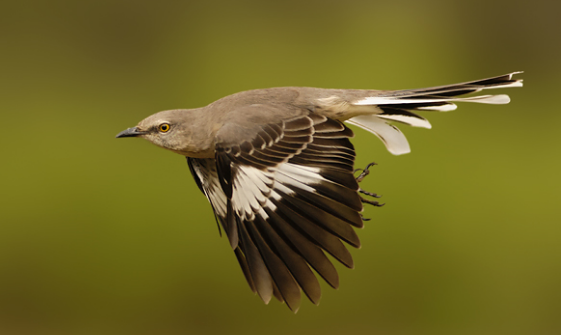
The northern mockingbird is the only mockingbird commonly found in North America. This bird is mainly a permanent resident, but northern birds may move south during harsh weather. This species has rarely been observed in Europe.
The northern mockingbird (Mimus polyglottos) is the only mockingbird commonly found in North America. This bird is mainly a permanent resident, but northern birds may move south during harsh weather. This species has rarely been observed in Europe. This species was first described by Linnaeus in his Systema Naturæ in 1758 as Turdus polyglottos. The northern mockingbird is known for its mimicking ability, as reflected by the meaning of its scientific name, ‘many-tongued mimic.’ The northern mockingbird has gray to brown upper feathers and a paler belly. Its tail and wings have white patches which are visible in flight.
The northern mockingbird is an omnivore. It eats both insects and fruits. It is often found in open areas and forest edges but forages in grassy land. The northern mockingbird breeds in southeastern Canada, the United States, northern Mexico, the Bahamas, the Cayman Islands and the Greater Antilles. It is replaced further south by its closest living relative, the tropical mockingbird. The Socorro mockingbird, an endangered species, is also closely related, contrary to previous opinion.
The northern mockingbird is known for its intelligence and has also been noted in North American culture. A 2009 study showed that the bird was able to recognize individual humans, particularly noting those who had previously been intruders or threats. Also birds recognize their breeding spots and return to areas in which they had greatest success in previous years. Urban birds are more likely to demonstrate this behavior. Finally, the mockingbird has influenced United States culture in multiple ways. The bird is a state bird of five different states, has been used in book titles, and has also been used in popular songs and lullabies among other appearances in U.S. culture.
RED-FOOTED BOOBY
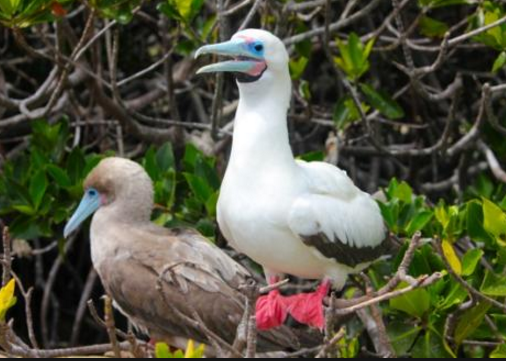
The red-footed booby is the smallest member of the booby and gannet family at about 70 cm (28 in) in length and with a wingspan of up to 1 m (3.3 ft). The average weight of 490 adults from Christmas Island was 837 g (1.845 lb). It has red legs, and its bill and throat pouch are coloured pink and blue. This species has several morphs. In the white morph the plumage is mostly white (the head often tinged yellowish) and the flight feathers are black. The black-tailed white morph is similar, but with a black tail, and can easily be confused with the Nazca and masked boobies. The brown morph is overall brown. The white-tailed brown morph is similar, but has a white belly, rump, and tail. The white-headed and white-tailed brown morph has a mostly white body, tail and head, and brown wings and back. The morphs commonly breed together, but in most regions one or two morphs predominates; e.g. at the Galápagos Islands, most belong to the brown morph, though the white morph also occurs.
The red-footed booby is also found in the National Trust’s Booby Pond Nature Resurve on Little Cayman.
In September 2016, a male red-footed booby was inexplicably found washed up on a beach in East Sussex, UK, 5,000 miles from its nearest usual habitat. It was the first of its species ever recorded in the UK. The bird, named Norman, was exhausted and malnourished. He was brought back to health before being transported by plane to join a flock of boobies in the Cayman Islands in December 2016.
WHITE-CROWNED PIGEON
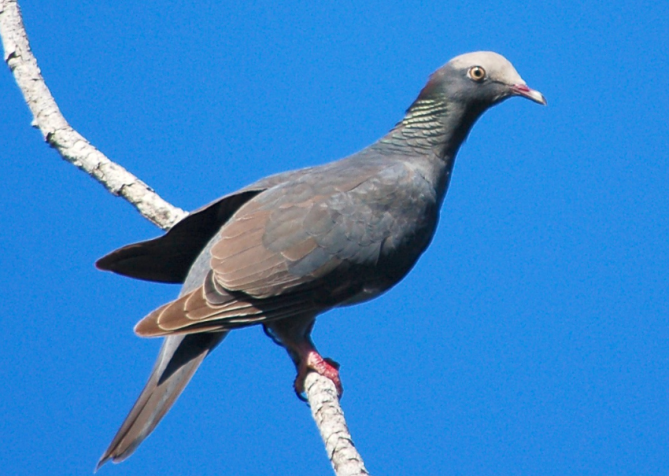
The white-crowned pigeon can measure 29–35 cm (11–14 in) in length, span 48–59 cm (19–23 in) across the wings, and weigh 150–301 g (5.3–10.6 oz). It is around the same size as the common rock pigeon, but weighs a bit less since it is generally less chunky and has a relatively longer tail. The adult is dark grey, with green and white bars on the nape, a brilliant white crown to the head, a white iris, and a pale-tipped red bill. Juveniles are a less dark shade of grey, lack the nape pattern and white iris, and show only a few pale feathers on the crown. The song is a series of mourning dove-like woo pop woooo calls; this species is a member of a diverse clade of Patagioenas which vary much in appearance, but are united by their triple coos (except in the scaled pigeon).
It is a resident breeder mainly in the Bahamas, Cuba, Jamaica and Antigua. It breeds in smaller numbers in Hispaniola, Puerto Rico, the Virgin Islands, the Cayman Islands, Anguilla and other Caribbean islands. It also breeds along the Caribbean coast of Central America. In the United States it is found only in the Florida Keys and the southern tip of mainland Florida.
The main threat to this species is hunting. In Florida a major cause of mortality is collision with man-made objects. Another main threat to this species is loss of habitat. The white-crowned pigeon needs two distinct habitats, one for nesting and one for feeding. They typically breed in coastal red mangroves (Rhizophora mangle), which continue to be clear-cut for crops such as sugarcane. Agriculture and deforestation have become a problem for the species’ feeding grounds, typically inland hardwood forests. The bird is very skittish, and is known to simply abandon its nest when it is encroached upon.
Like the extinct passenger pigeon this species “illustrates a very important principle of conservation biology: it is not always necessary to kill the last pair of a species to force it to extinction. These birds are “threatened by the slaughter of nesting birds on its Caribbean breeding grounds.”
WEST INDIAN WOODPECKER
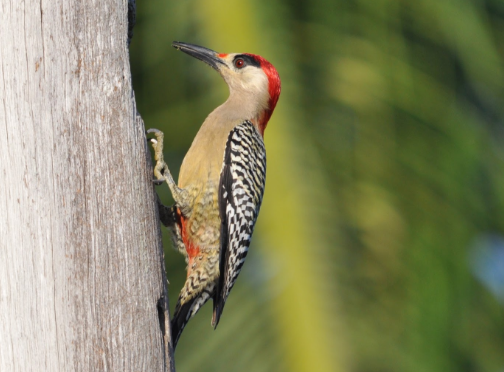
The West Indian woodpecker (Melanerpes superciliaris) is a species of bird in the family Picidae. It is found in the Bahamas, Cayman Islands and Cuba. Its natural habitats are subtropical or tropical dry forests, subtropical or tropical moist lowland forests, subtropical or tropical mangrove forests, and heavily degraded former forest.
The species has been observed to have a polyandrous breeding system, with one female raising two broods with different males concurrently.
WEST INDIAN WHISTLING DUCK

The West Indian whistling duck (Dendrocygna arborea) is a whistling duck that breeds in the Caribbean. Alternative names are black-billed whistling duck and Cuban whistling duck.
The West Indian whistling duck is widely scattered throughout the West Indies, including a large breeding population in the Bahamas, and smaller numbers in Cuba, the Cayman Islands, Antigua and Barbuda, and Jamaica. It is largely sedentary, apart from local movements, which can be 100 km or more. Nests have been reported in tree cavities, on branches, in clumps of bromeliads, and on the ground under thatch palms and other dense bushes. The usual clutch size is 10-16 eggs. It habitually perches in trees, which gives rise to its specific name.
The birds are mostly nocturnal and secretive, inhabiting wooded swamps and mangroves, where this duck roosts and feeds on plant food including the fruit of the Royal Palm.
The West Indian whistling duck is the largest (48–56 cm) and darkest of its genus. It has a long black bill, long head and longish legs. It has a pale foreneck and light brown face. The crown, back, breast and wings are dark brown to black, and the rest of the underparts are white with heavy black markings.
All plumages are similar, except that juveniles are duller and have a less contrasted belly pattern.
BLACK-BELLIED WHISTLING DUCK
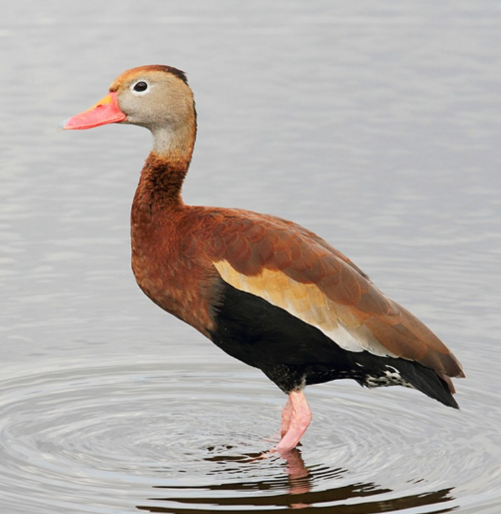
The black-bellied whistling duck (Dendrocygna autumnalis), formerly also called black-bellied tree duck, is a whistling duck that breeds from the southernmost United States and tropical Central to south-central South America. In the USA, it can be found year-round in parts of southeast Texas, and seasonally in southeast Arizona, and Louisiana’s Gulf Coast. It is a rare breeder in such disparate locations as Arkansas, Georgia, Tennessee, and South Carolina, though it is now a common breeder in parts of central Florida. There is a large population of several hundred that winter each year in Audubon Park in uptown New Orleans, Louisiana. Since it is one of only two whistling-duck species native to North America, it is occasionally just known as the “whistling duck” in the southern USA.
SCARLET IBIS
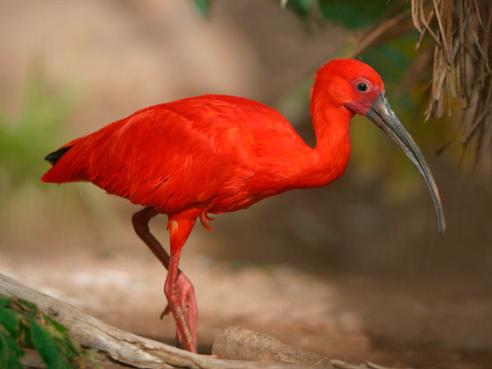
The scarlet ibis (Eudocimus ruber) is a species of ibis in the bird family Threskiornithidae. It inhabits tropical South America and islands of the Caribbean. In form it resembles most of the other twenty-seven extant species of ibis, but its remarkably brilliant scarlet coloration makes it unmistakable. It is one of the two national birds of Trinidad and Tobago.
This medium-sized wader is a hardy, numerous, and prolific bird, and it has protected status around the world. Its IUCN status is Least Concern. The legitimacy of Eudocimus ruber as a biological classification, however, is in dispute. Traditional Linnaean taxonomy classifies it as a unique species, but some scientists have moved to reclassify it as a subspecies of a more general American ibis species, along with its close relative, the American white ibis (Eudocimus albus).
GREATER ANTILLEAN GRACKLE
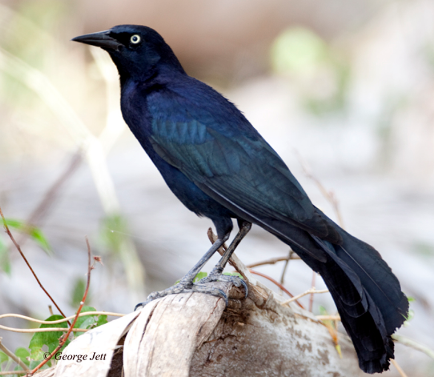
The Greater Antillean grackle is a grackle found throughout the Greater Antilles as well as smaller, nearby islands. Like all Quiscalus grackles, it is a rather large, gregarious bird. It lives largely in heavily settled areas.
The 27 cm (11 in)-long male is glossy black with a large rudder-like tail; the 24 cm (9.4 in)-long female has a smaller tail and is similar in color but less glossy than the male. The eye is yellow and is the only non-black body part.
There are seven subspecies, each restricted to one island or island group.[3] They differ from the nominate Q. n. niger subspecies in size, bill size, and colour tone.
The Greater Antillean Grackle (Quiscalus niger), is a native bird of Cuba. It is also found on other major Caribbean islands such as Puerto Rico, Jamaica, and Hispaniola hence the name “Greater Antilles” (Neotropical birds). The Greater Antillean Grackle is divided into seven subspecies that are found in smaller islands separate from the Greater Antilles. The Greater Antillean Grackle belongs to the Icteridae family which are basically the blackbirds found in the New World (Oiseaux-birds). There have been a number of Grackles observed in the United States and Mexico even though those Grackles belong to different subspecies rather than the Greater Antillean Crackle (Quiscalus niger), it is significant to understand what it is that distinguishes the Greater Antillean Crackle from the other Grackles (Powell, Alexis).
BARN OWL
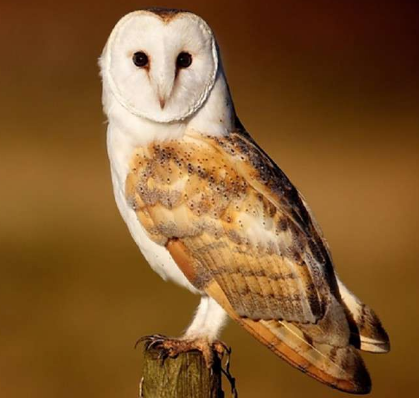
The barn owl (Tyto alba) is the most widely distributed species of owl and one of the most widespread of all birds. It is also referred to as the common barn owl, to distinguish it from other species in its family, Tytonidae, which forms one of the two main lineages of living owls, the other being the typical owls (Strigidae). The barn owl is found almost everywhere in the world except polar and desert regions, Asia north of the Himalayas, most of Indonesia, and some Pacific islands.
Phylogenetic evidence shows that there are at least three major lineages of barn owl, one in Europe, western Asia and Africa, one in southeast Asia and Australasia, and one in the Americas, and some highly divergent taxa on islands. Accordingly some authorities split the group into the western barn owl for the group in Europe, western Asia and Africa, the American barn owl for the group in the Americas, and the eastern barn owl for the group in southeast Asia and Australasia. Some taxonomic authorities further split the group, recognising up to five species, and further research needs to be done to clarify the position. There is a considerable variation between the sizes and colour of the approximately 28 subspecies but most are between 33 and 39 cm (13 and 15 in) in length with wingspans ranging from 80 to 95 cm (31 to 37 in). The plumage on head and back is a mottled shade of grey or brown, the underparts vary from white to brown and are sometimes speckled with dark markings. The face is characteristically heart-shaped and is white in most subspecies. This owl does not hoot, but utters an eerie, drawn-out shriek.